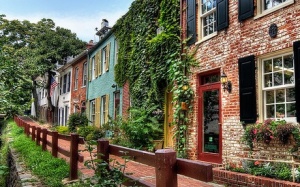 From Atlantic Cities writer Richard Florida (citing McMahon throughout): "The key function of a city is to enable exchange, interaction, and the combination and recombination of people and ideas. When buildings become so massive that street life disappears, they can damp down and limit just this sort of interaction, creating the same isolation that is more commonly associated with sprawl.
"Jane Jacobs aptly put it: 'in the absence of a pedestrian scale, density can be big trouble.' Skyscraper canyons of the sort that are found in many Asian mega-cities, and that are increasingly proposed in great American cities, risk becoming vertical suburbs, whose residents and occupants are less likely to engage frequently and widely with the hurly-burly of city life.
From Atlantic Cities writer Richard Florida (citing McMahon throughout): "The key function of a city is to enable exchange, interaction, and the combination and recombination of people and ideas. When buildings become so massive that street life disappears, they can damp down and limit just this sort of interaction, creating the same isolation that is more commonly associated with sprawl.
"Jane Jacobs aptly put it: 'in the absence of a pedestrian scale, density can be big trouble.' Skyscraper canyons of the sort that are found in many Asian mega-cities, and that are increasingly proposed in great American cities, risk becoming vertical suburbs, whose residents and occupants are less likely to engage frequently and widely with the hurly-burly of city life.
"Stop and think for a moment: What kind of environments spur new innovation, start-ups and high-tech industries? Can you name one instance, one, of this sort of creative destruction occurring in high-rise office or residential towers, in skyscraper districts? The answer is no. High-rise districts typically house either corporate office functions or residences.
"What we need are new measures of density that do not simply count how many people we can physically cram into a space but that accounts for how well the space is utilized, the kinds of interactions it facilitates. Real interactive density can be better achieved by other means." Full article here.
Commentary from Better! Cities & Towns writer Robert Steuteville: "Like a preacher in an urban-revival tent, Richard Florida roused the gathering at last week’s 20th Congress for the New Urbanism in West Palm Beach, Florida. Florida made the provocative point that it is false that density and skyscrapers are the key ingredients to urban vitality and innovation. 'This rush to density, this idea that density creates economic growth,' is wrong, he said. “It’s the creation of real, walkable urban environments that stir the human spirit. Skyscraper communities are vertical suburbs, where it is lonely at the top. The kind of density we want is a "Jane Jacobs density."'" Full article here.
Further commentary from Transit Miami writer Craig Chester: "In her influential book, Death and Life of American Cities (1961), Jacobs objected to neighborhoods that were made up exclusively of high-rises and instead preferred neighborhoods with buildings that are a mix of different building ages and types – Greenwich Village in New York City, for example. When you consider cities around the world, it is in those types of neighborhoods where you will often find the arts districts, the best music venues, the creatives, the authentic, the local businesses, the innovators, the vitality – and a sense of place and community." Full post here. (Photo credit: Flickr user terratrekking.)
